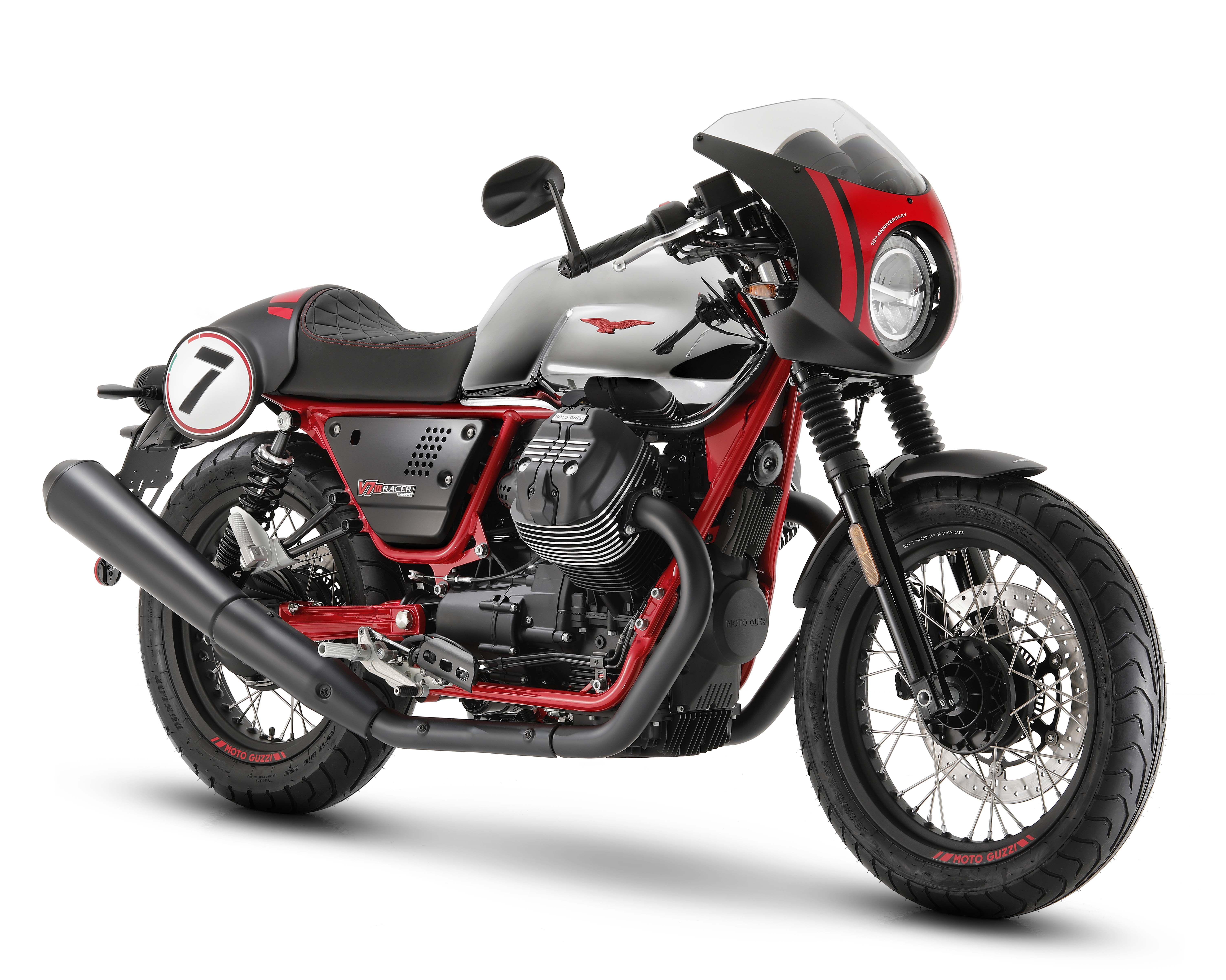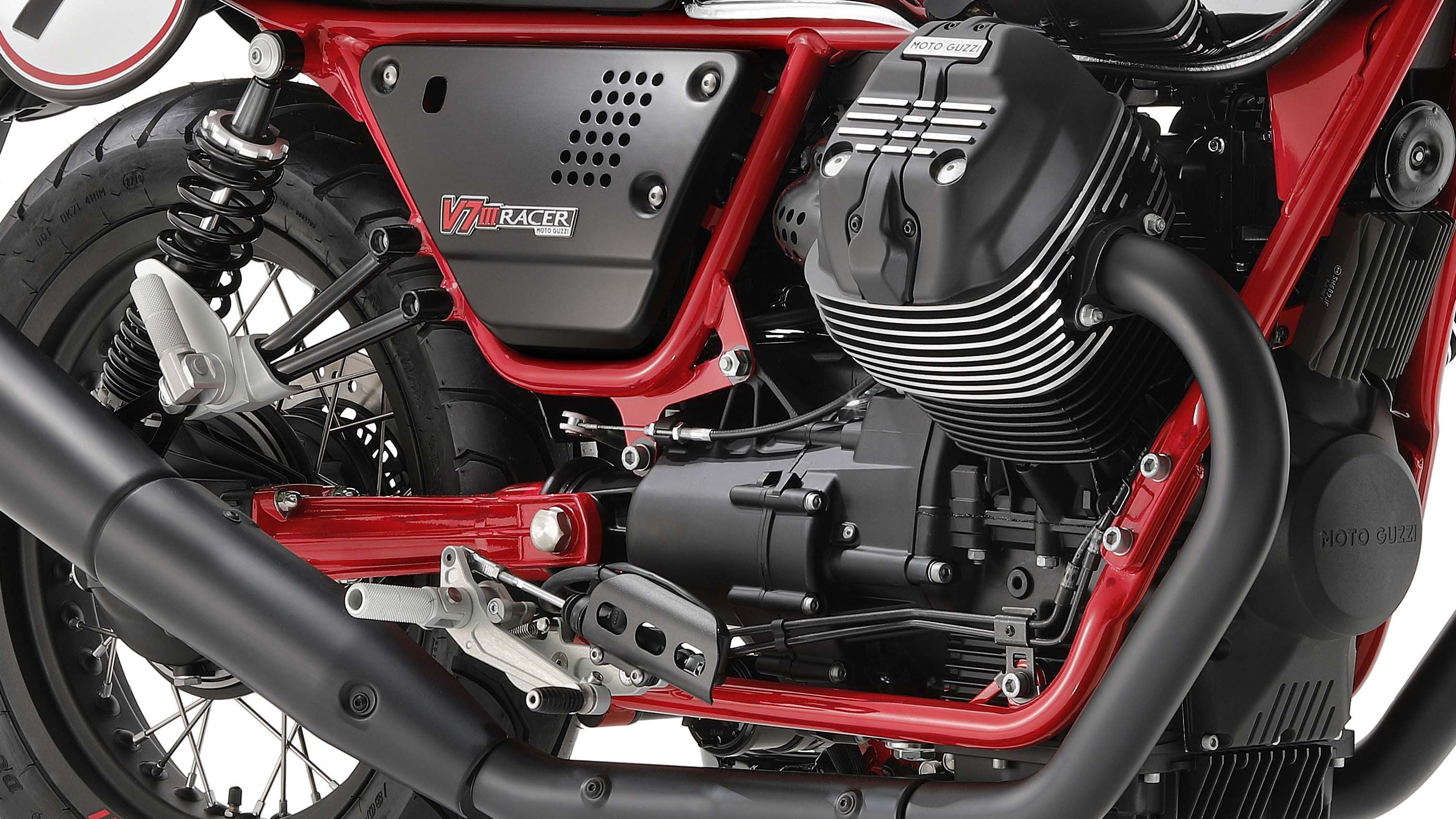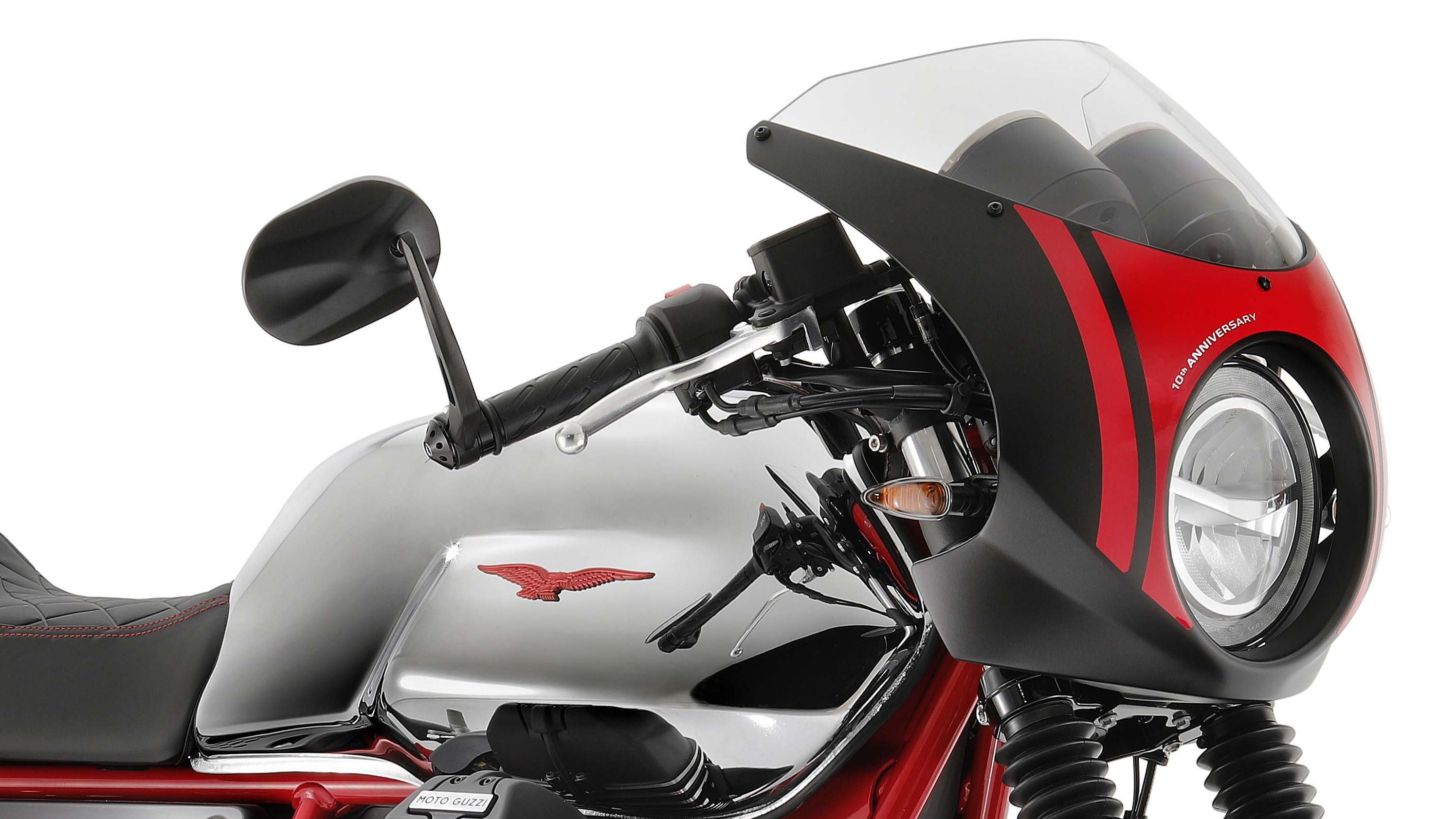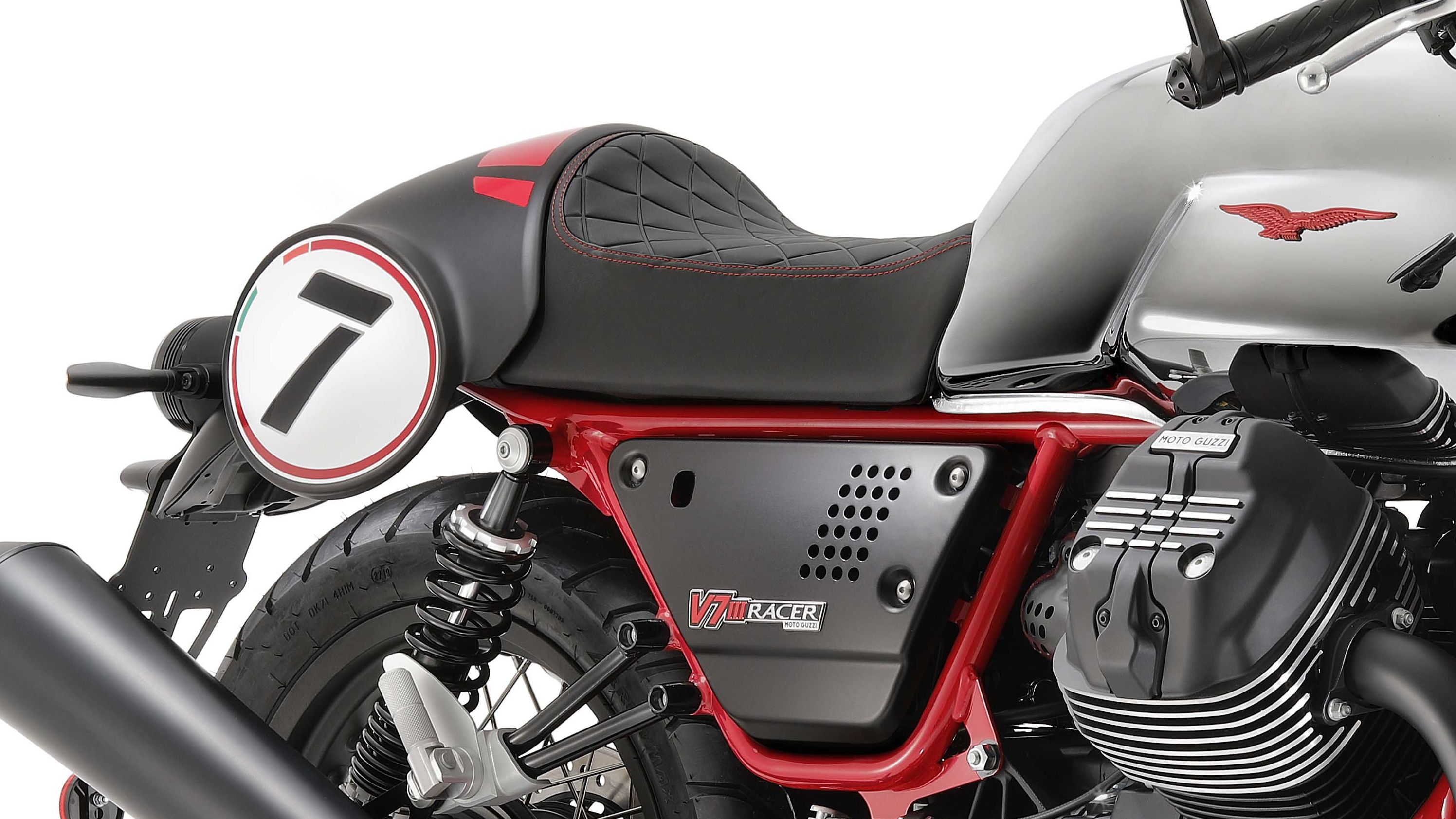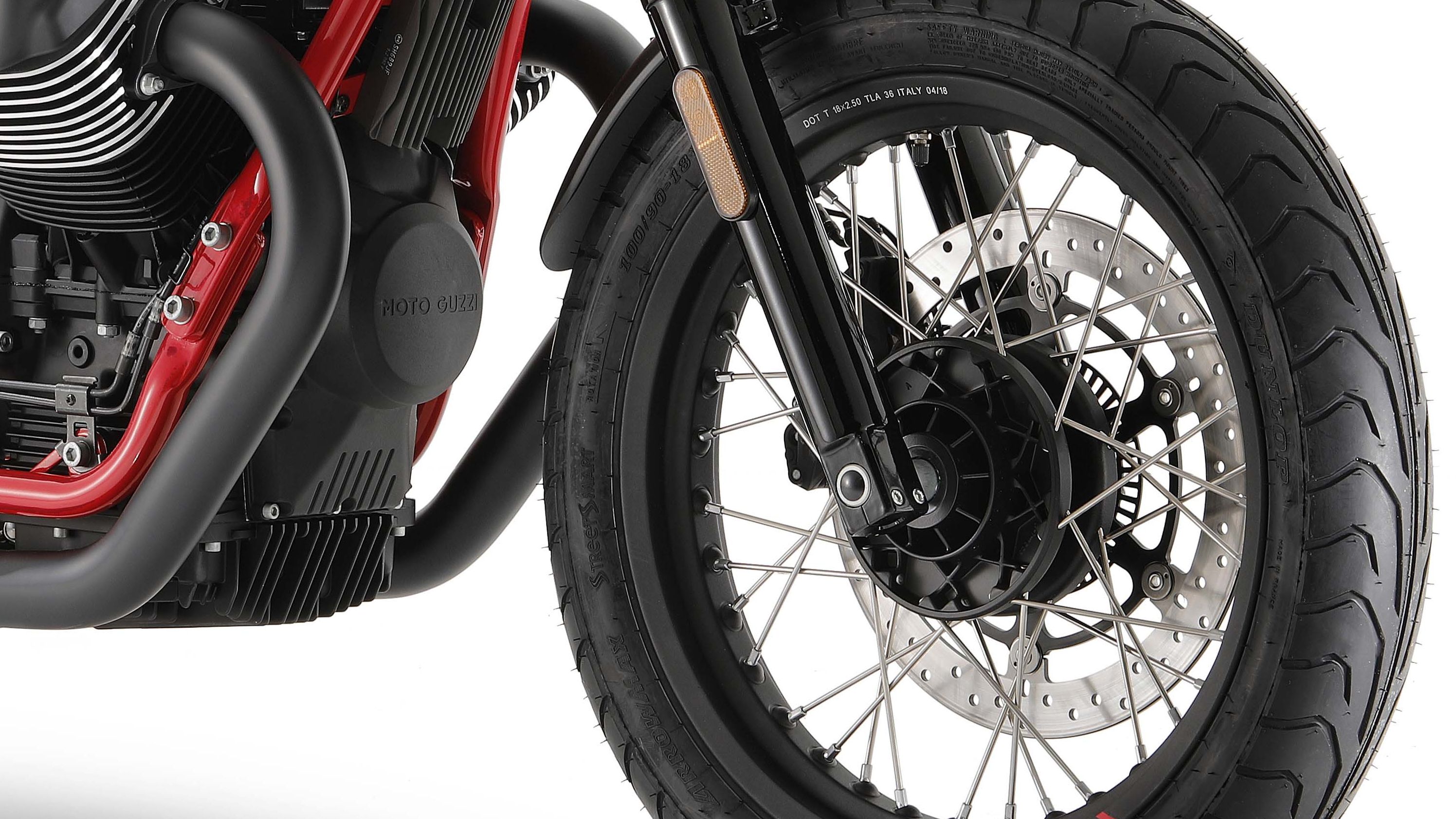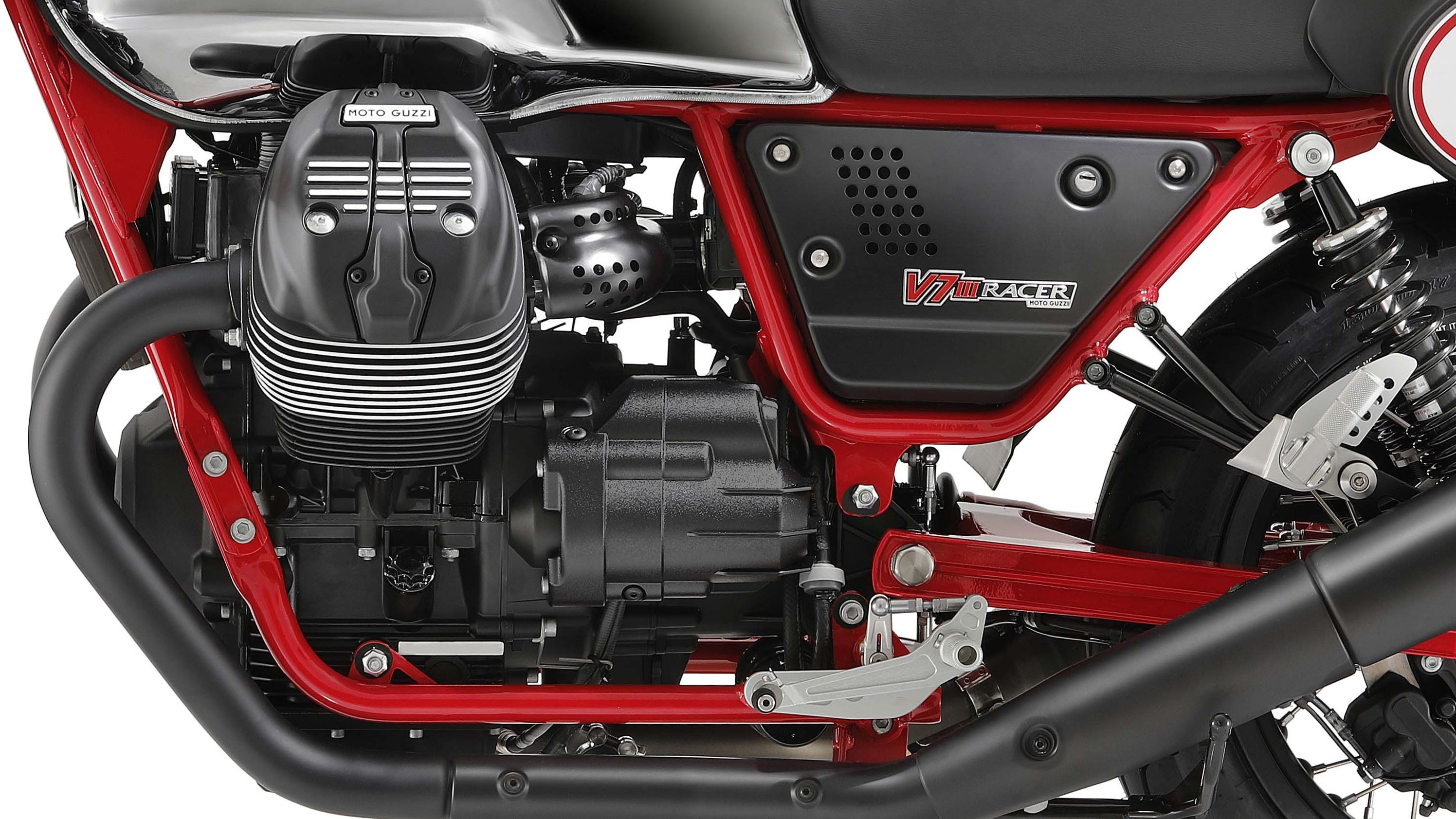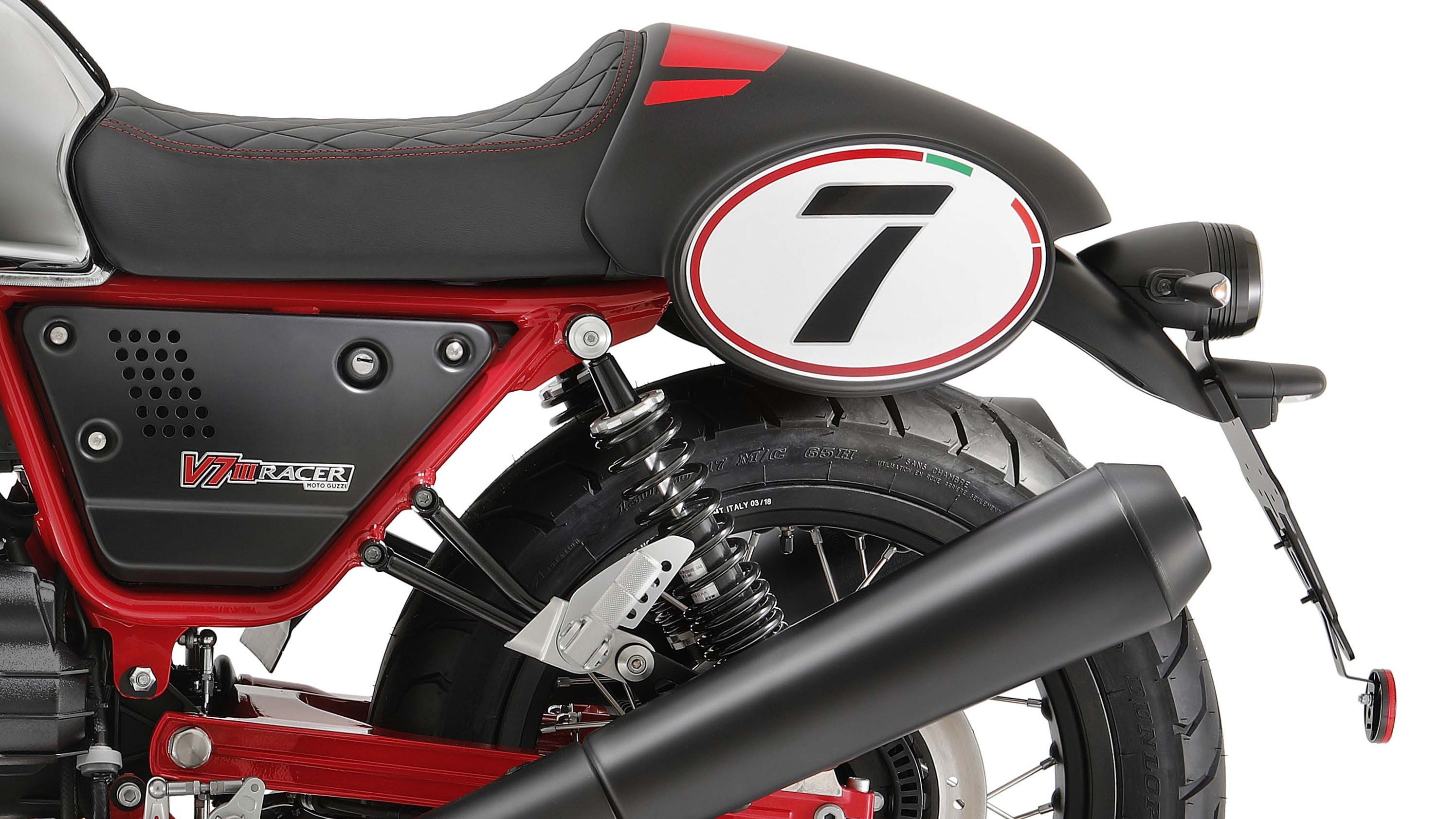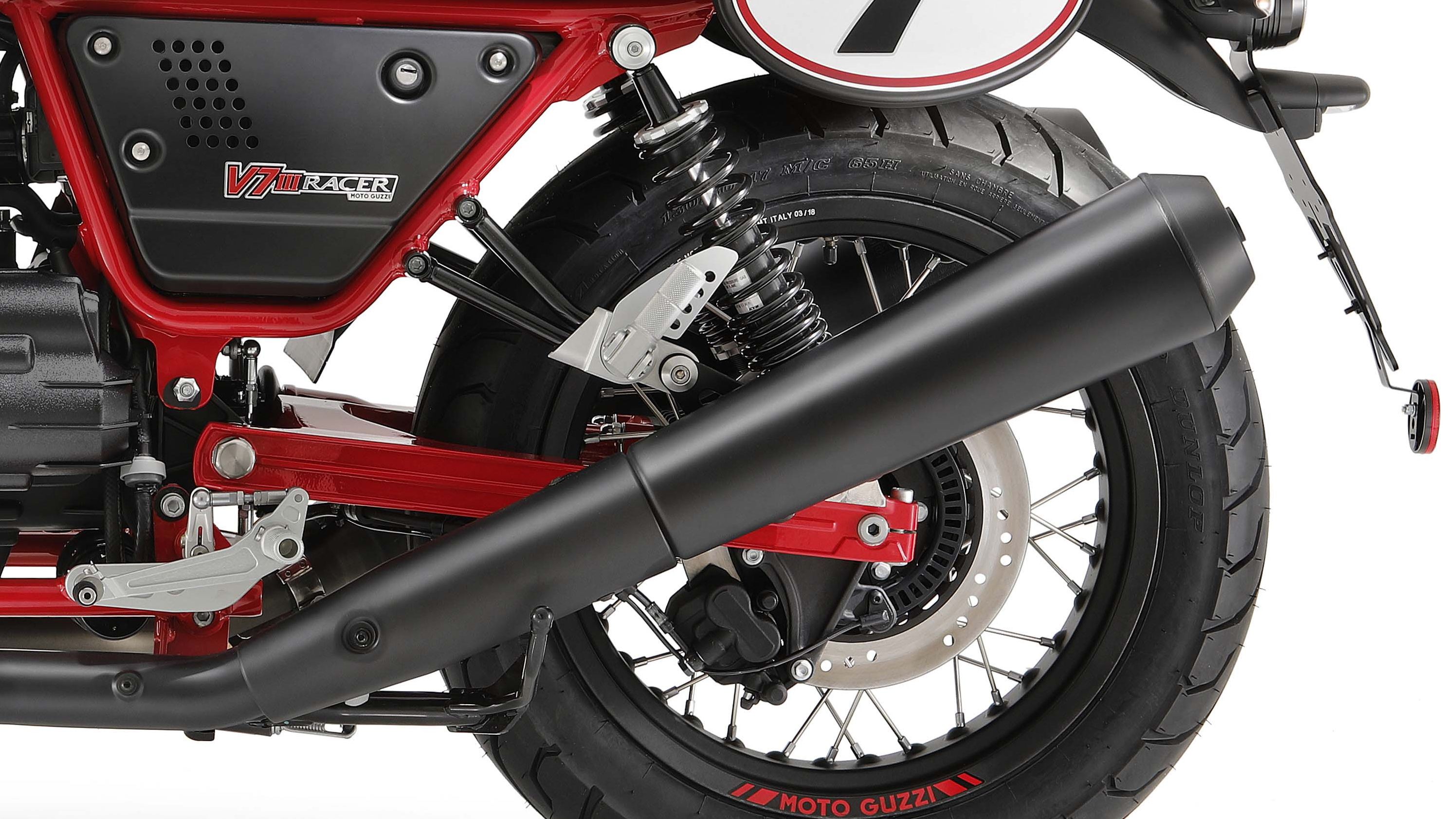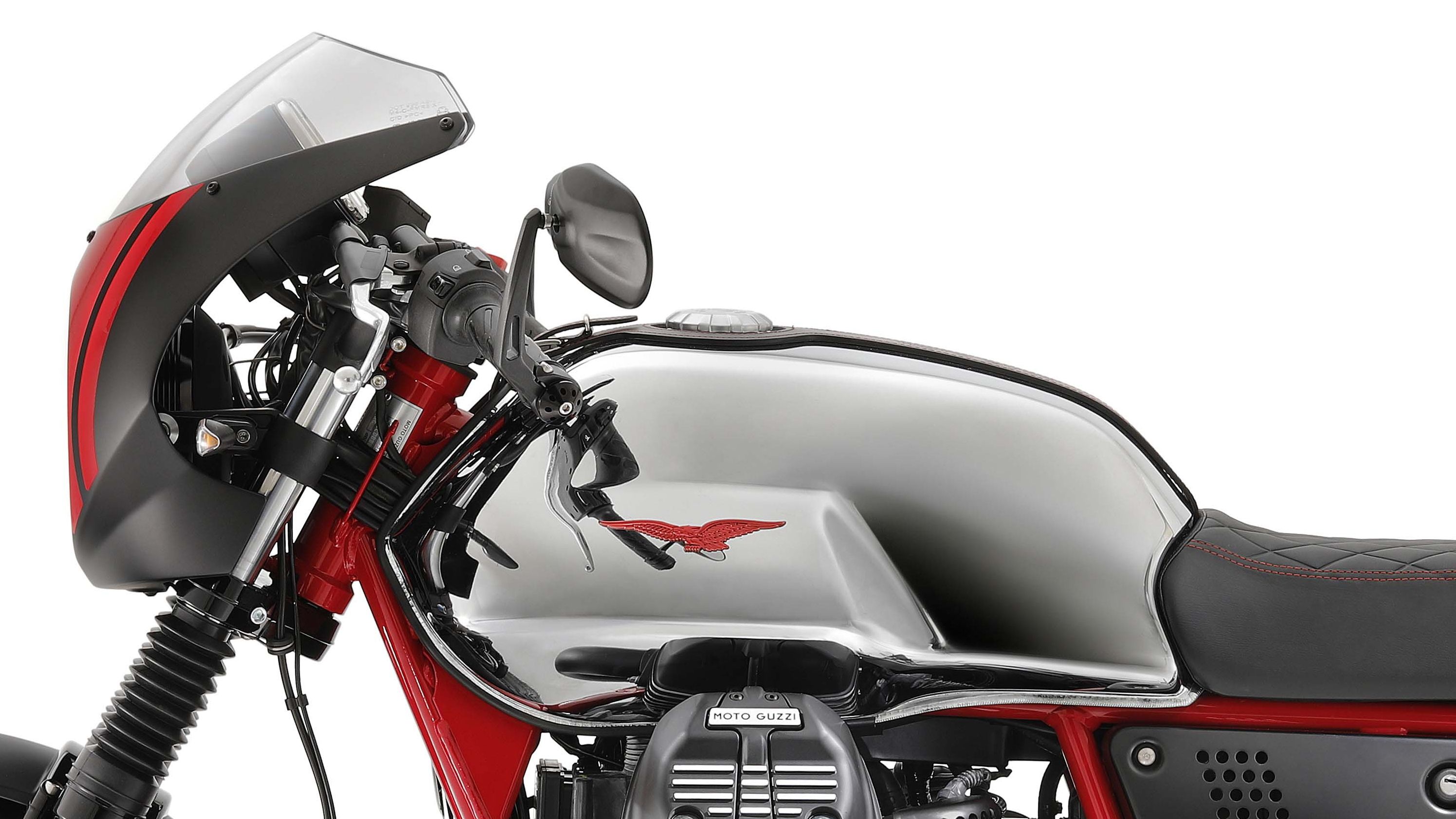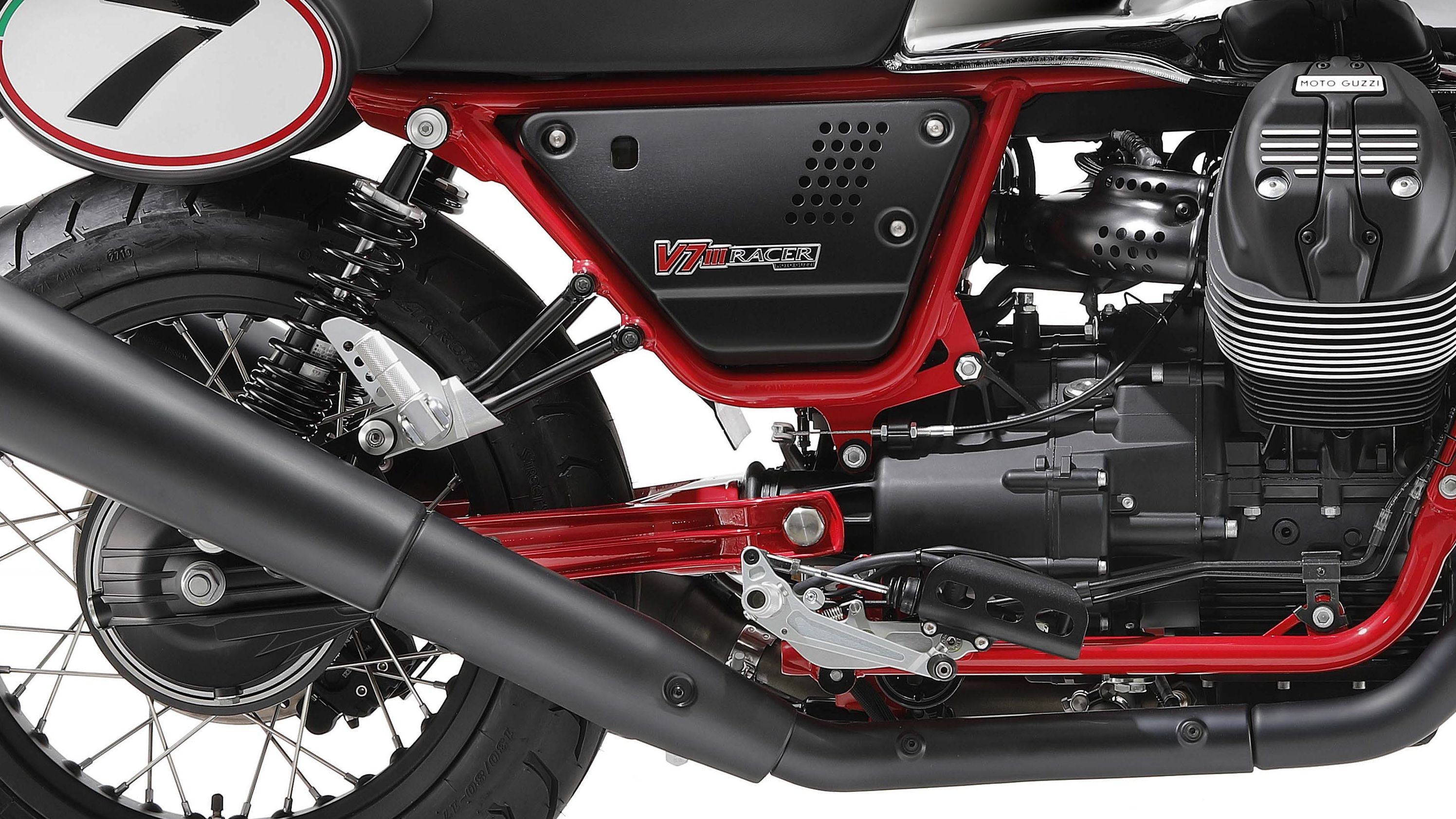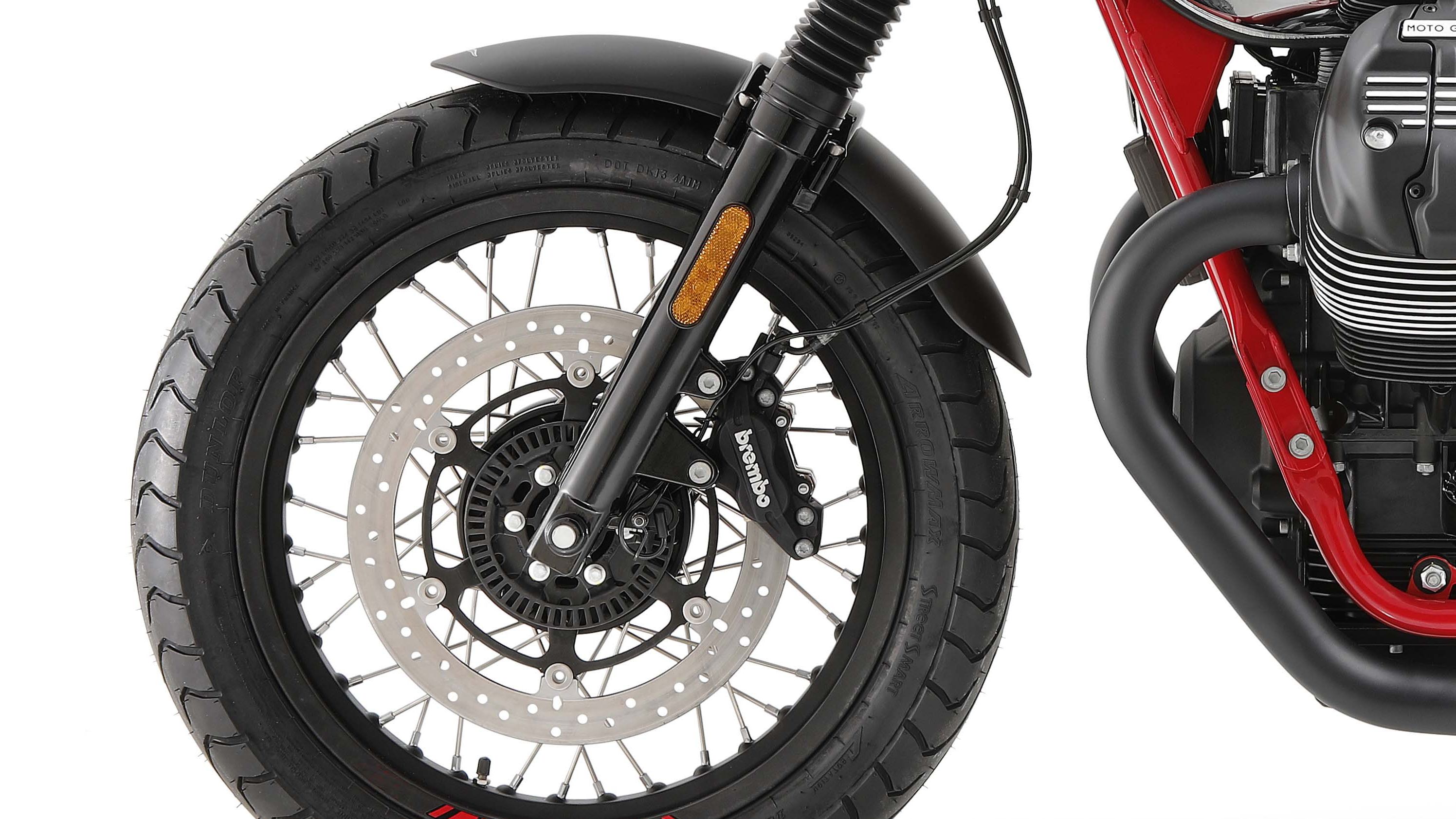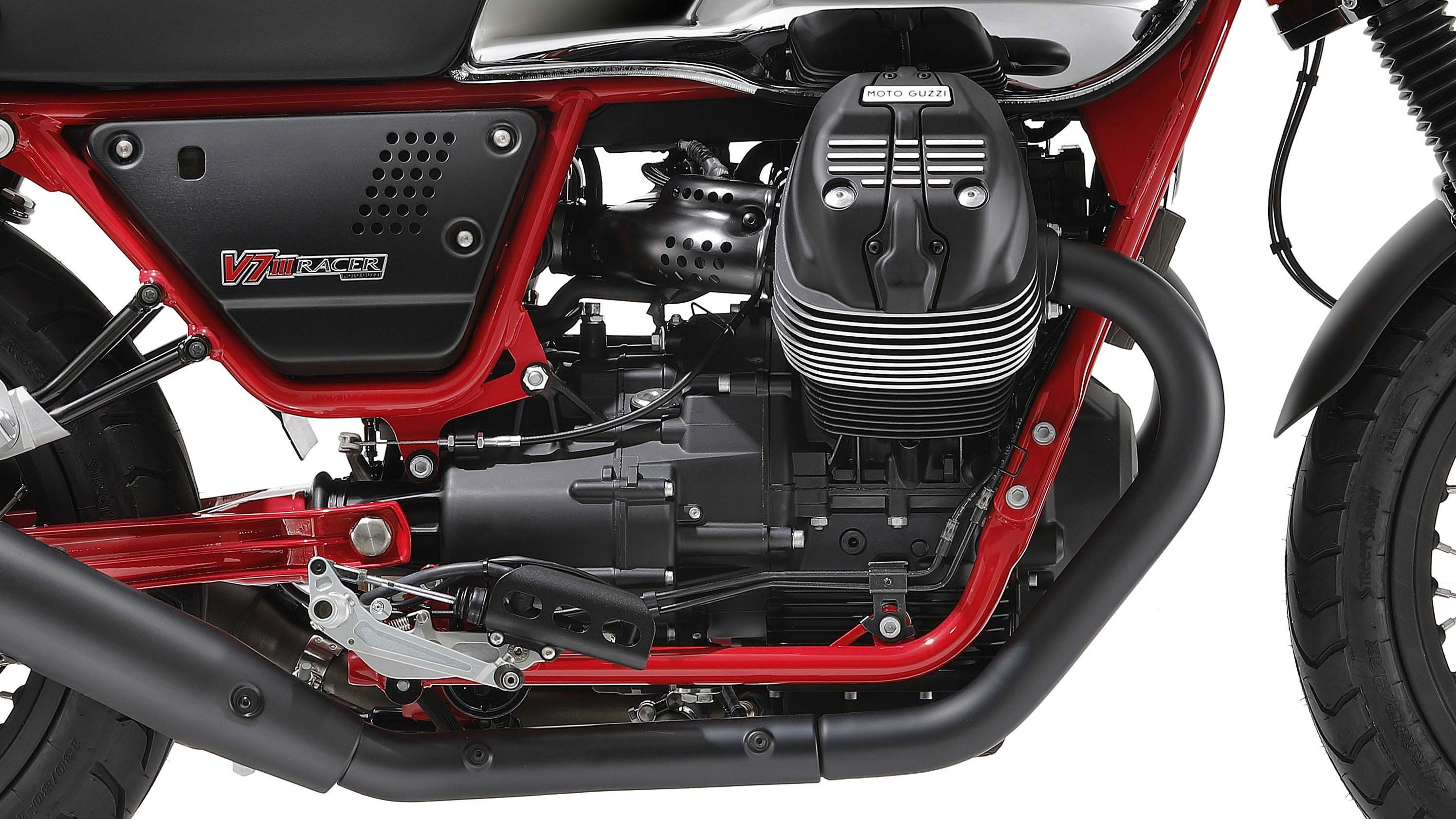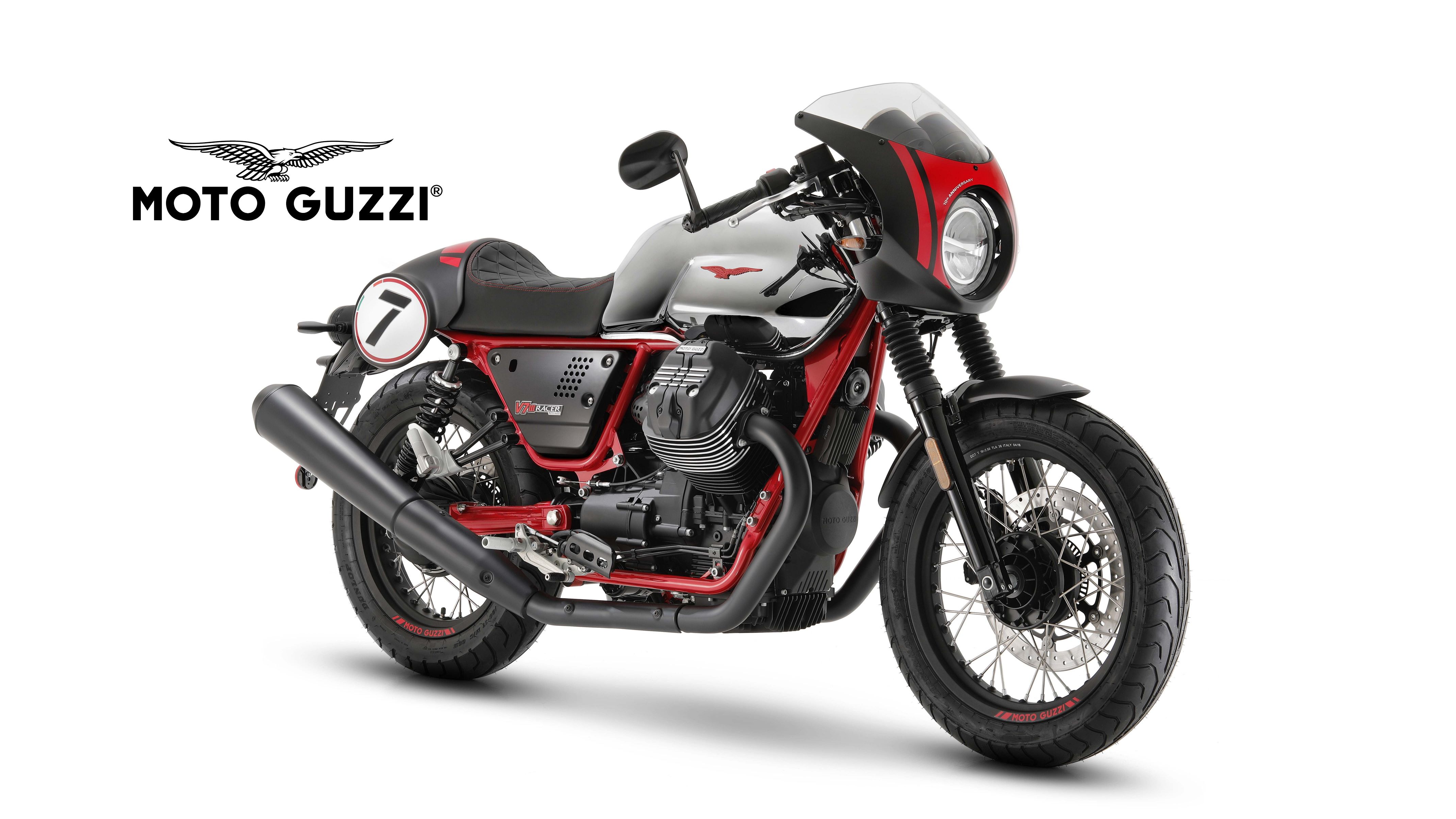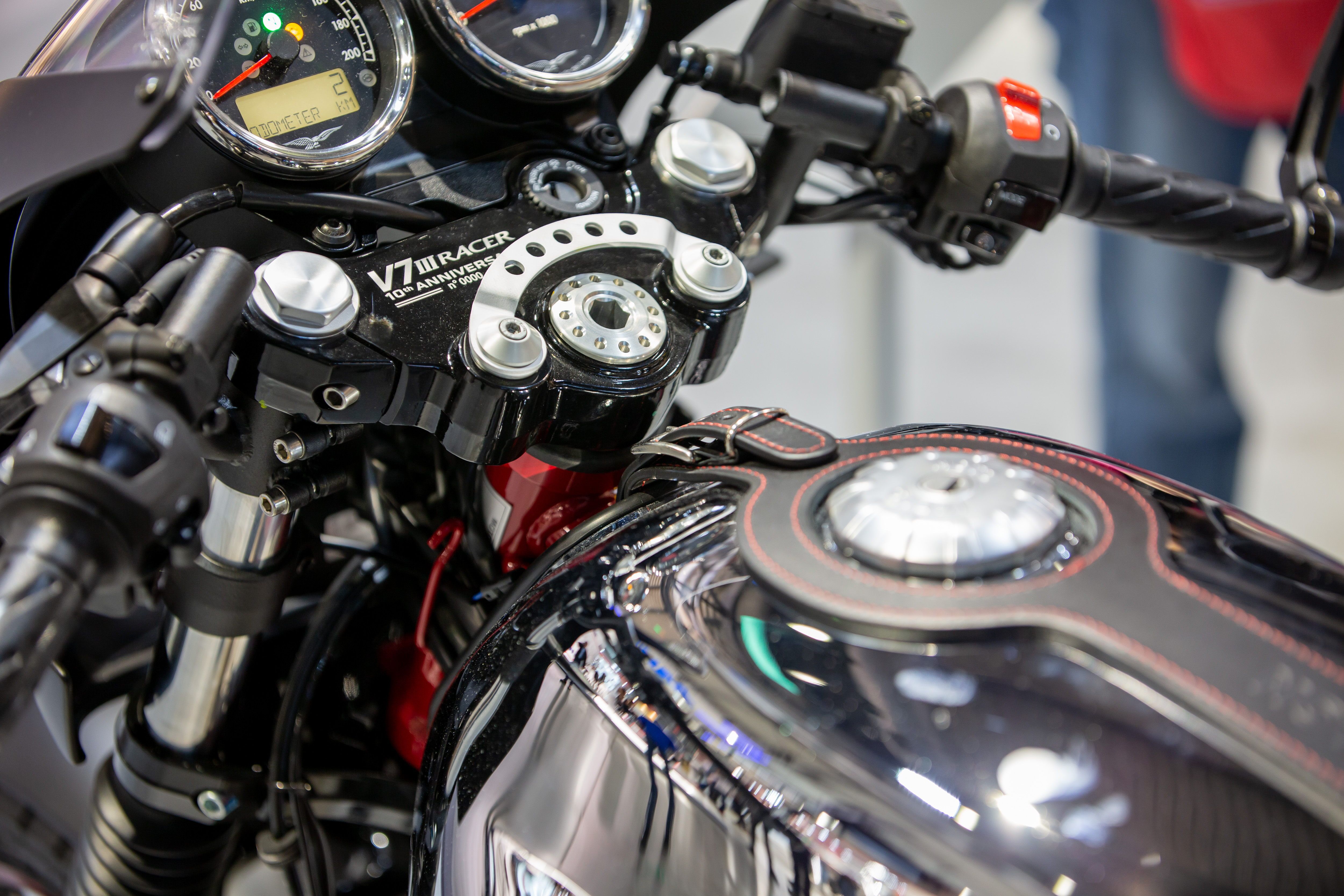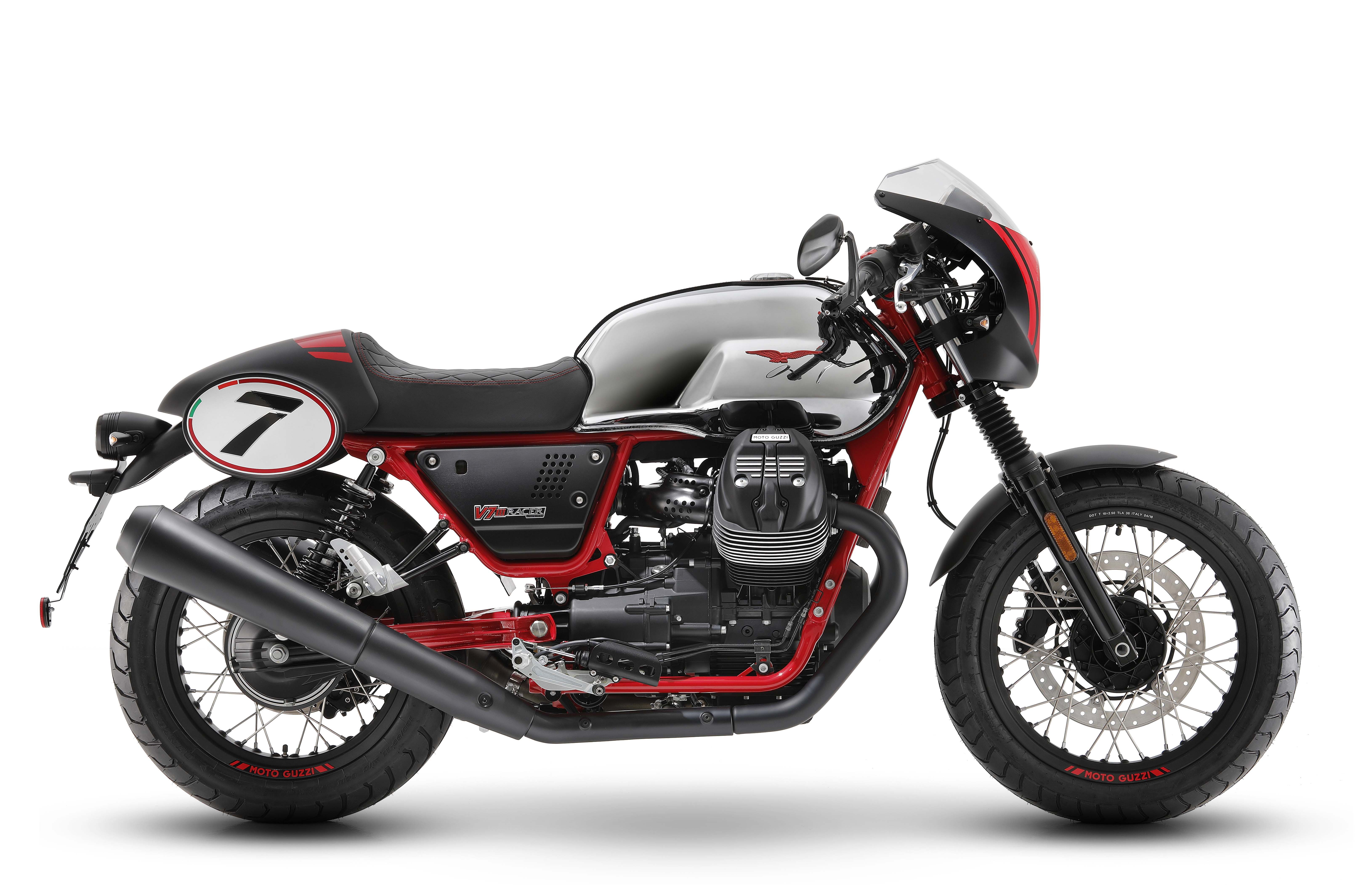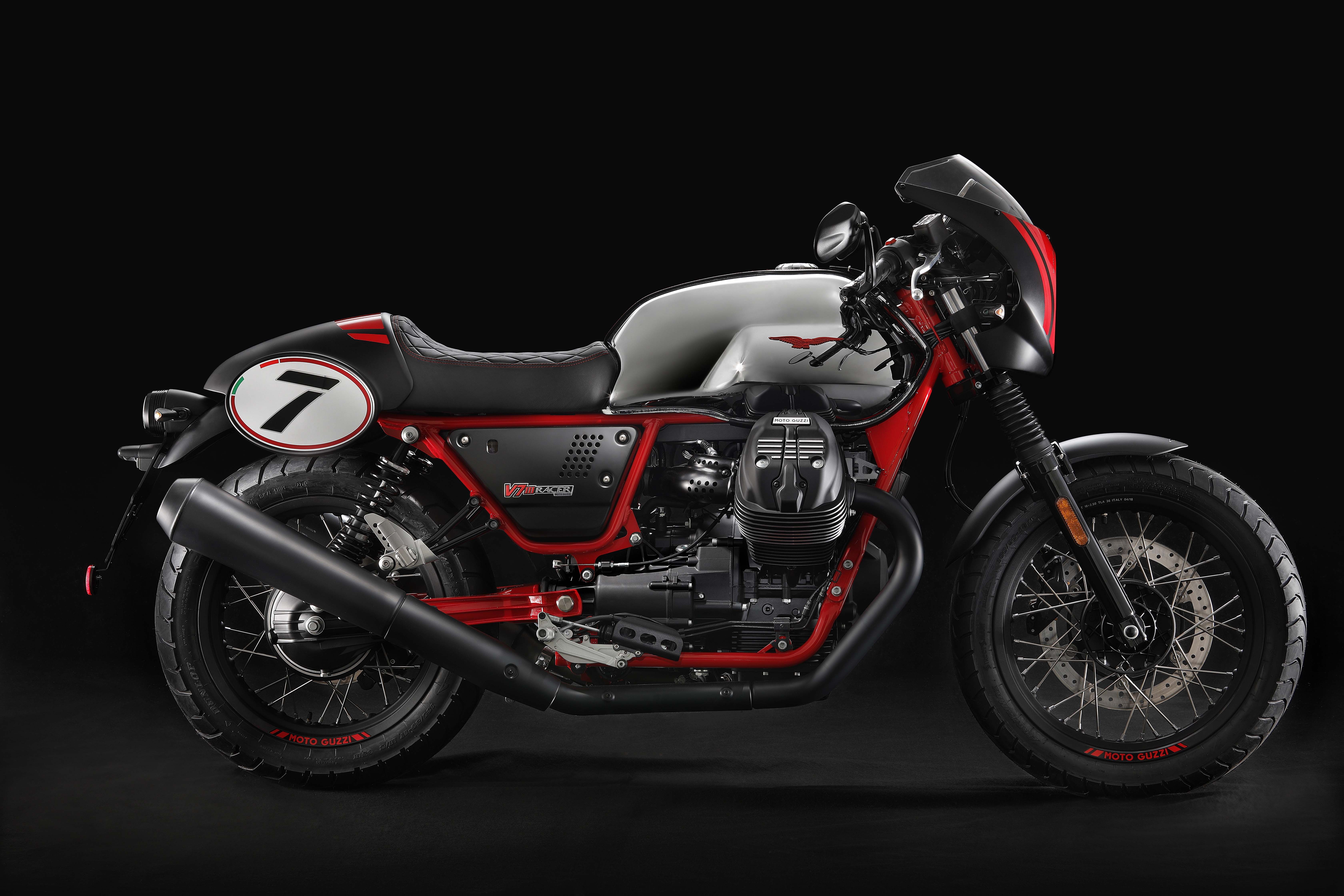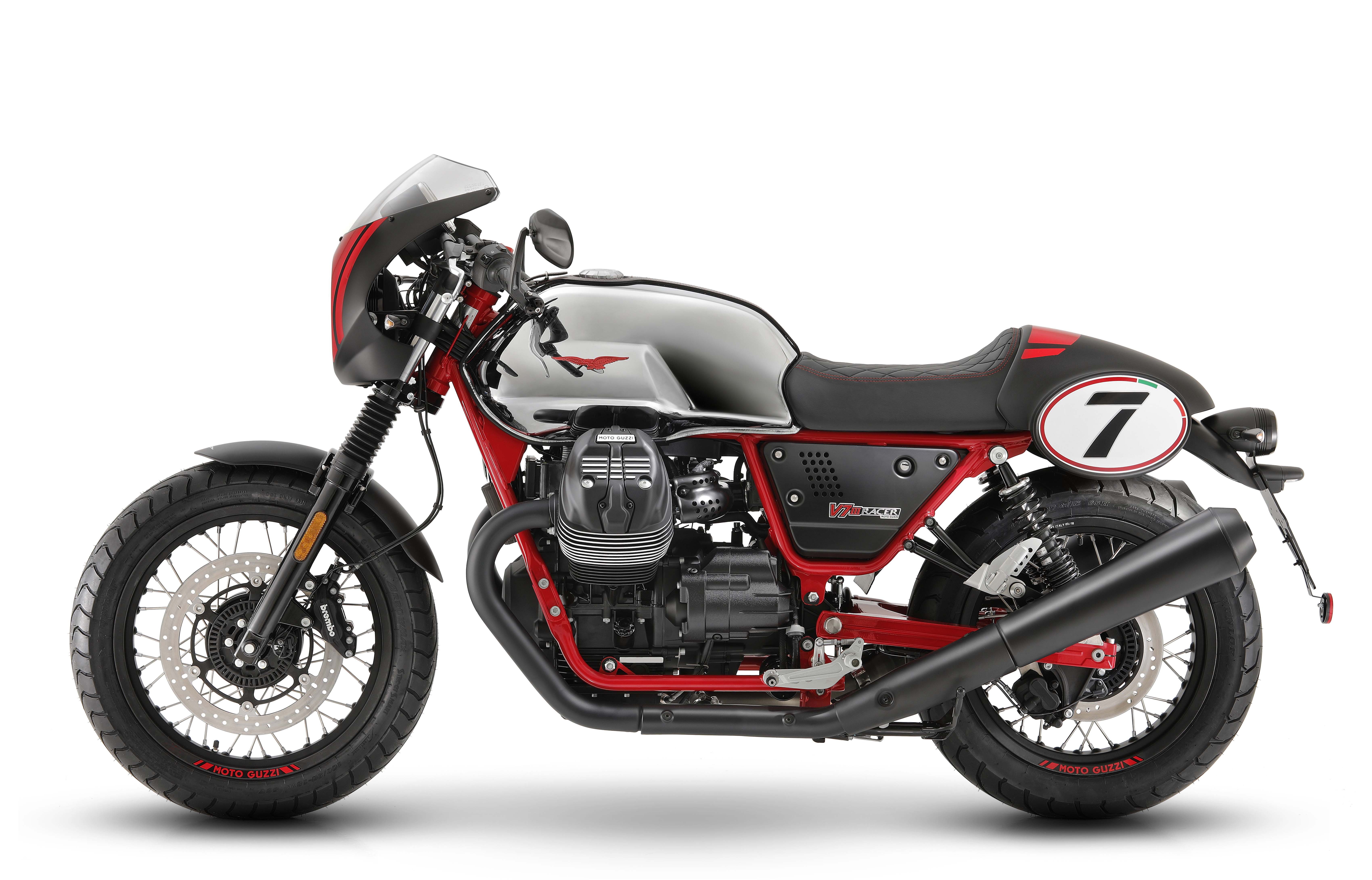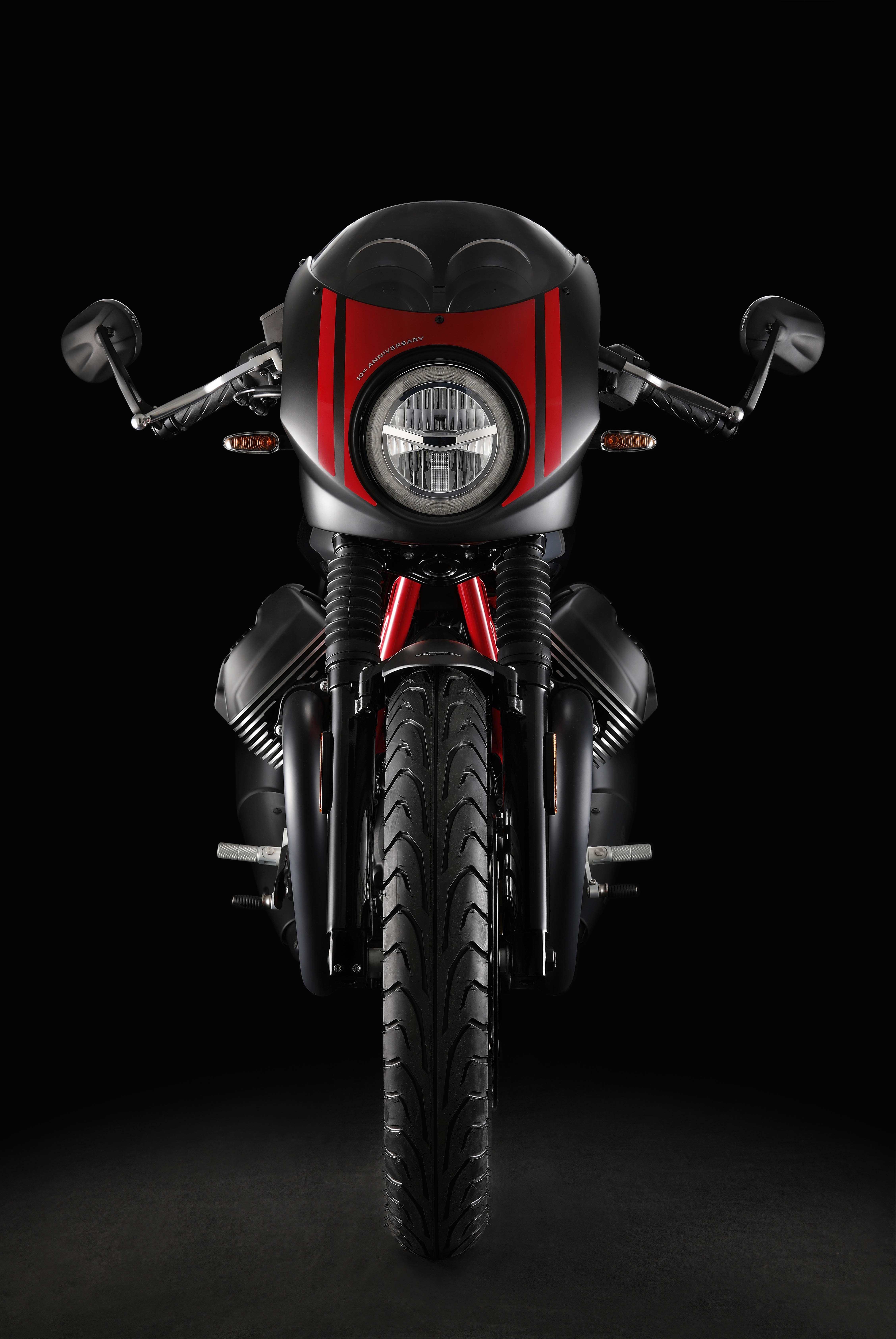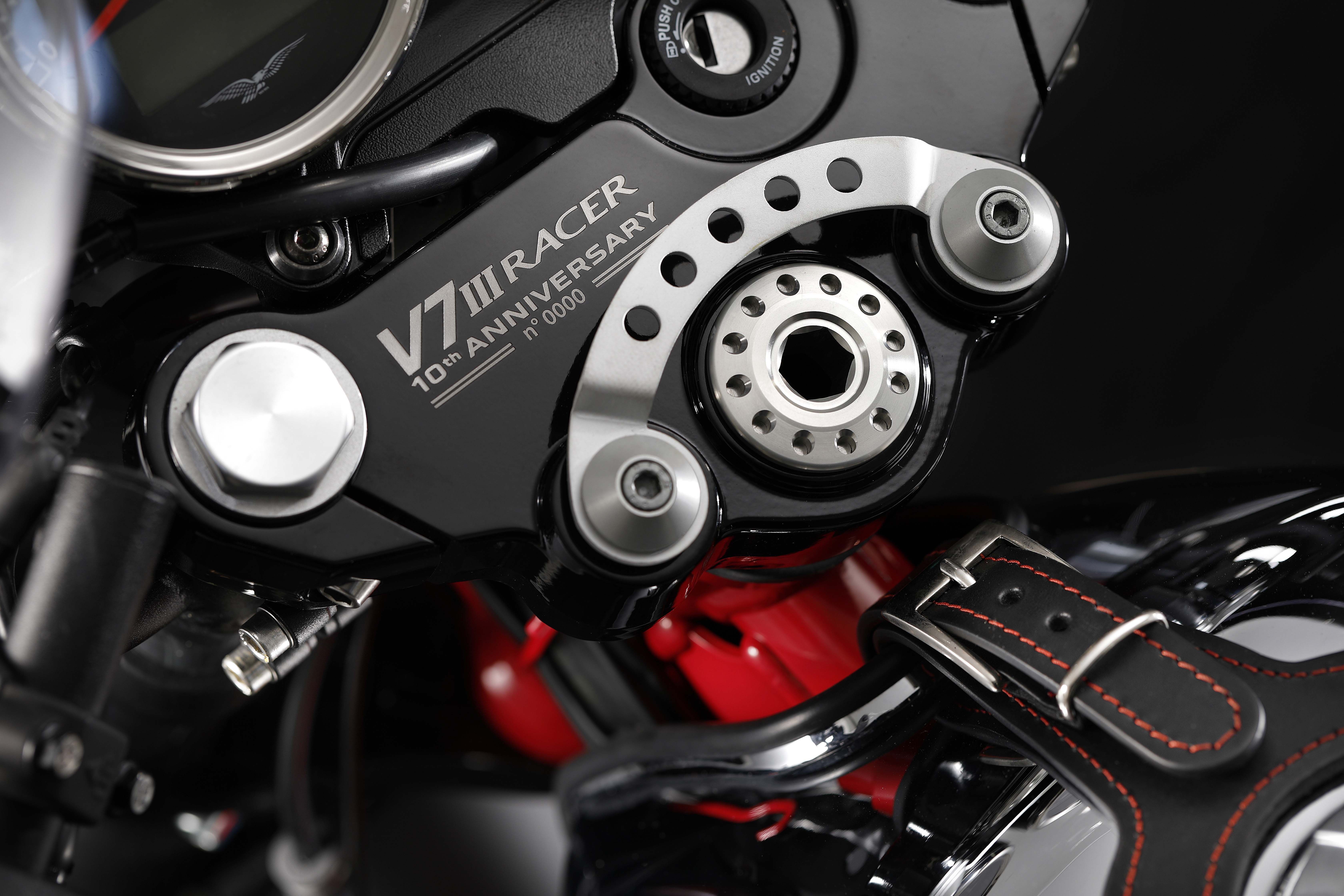Moto Guzzi celebrates a decade of V7 Racer bikes with the 2020 V7 III Racer 10th Anniversary. The factory builds on the third and current generation V7 Racer with some café-tastic bodywork that sets it apart from the base model. There are Easter Eggs a'plenty from models past scattered about this celebratory machine to turn it into something of a rolling tribute piece. As with the rest of the V7 III line, power comes from the signature, transverse-mount V-twin with over 50 ponies on tap and a new, adjustable, house-brand traction control feature to help you keep it under control. Under the hood, wireless connectivity to web-based services brings an infotainment element to the table along with bonafide modern credentials.
2020 Moto Guzzi V7 III Racer 10th Anniversary
- Make: Array
- Model: 2020 Moto Guzzi V7 III Racer 10th Anniversary
- Engine/Motor: V-Twin
- [do not use] Vehicle Model: Array
2020 Moto Guzzi V7 III Racer 10th Anniversary Design
For the V7 III Racer 10th Anniversary, the factory needed a way to add a bit of café racer style to an already café-tastic machine. It did so through the use of the tiniest suggestion of a classic bullet fairing. It sports a clear screen atop black mullions that meet in the middle to house the round headlight. Special, model-unique red graphics pick up by the red-and-black, racing tail cover that comes complete with oval racing number plates to finish out the café-racer package. The number 7 is run as a nod to the previous generations of V7 machines, and the edge of the plates have the detail of the Italian flag to further set it apart from the rest of the range.
A cut-down fender leads the way in keeping with its racing roots, a look backed up by the old-school black bellow gaiters that protect the swept area of the inner forks. The control bars are of the clip-on variety to pull you forward into an aggressive posture entirely appropriate for the genre.
Two round analog gauges – tach and speedo – with a handful of indicator lights and a small LCD screen wrap up the instrumentation and act as a visual reference for the higher electronic functions. Bar-end mirrors finish off the front-end gear and keep the upper lines clean with their low-rise standoffs and oval shape for yet another classic touch. The 5.5-gallon fuel tank bears the peculiar shoulders typical of the marque for the visual fairing effect they provide for the engine heads protruding from both sides of the bike.
Red stitching on the saddle gives the upholstery a unique flair, and if you like to share the fun with a friend, remove the tail cowl to expose the pillion pad. Fold-up, billet-aluminum passenger pegs finish off the passenger's points of contact.
Finally, a narrow rear fender mounts the gear in the rear with the taillight, turn signals and plateholder all on board. All-around LED lighting ensures that they can see you both coming and going, even in daylight.
2020 Moto Guzzi V7 III Racer 10th Anniversary Chassis
Laced wheels on the V7 III Racer 10th Anniversary make yet another classic connection that also veers into custom territory with blackout treatment. That monochromatic finish extends to the lower fork slider on the front stems, the tripletree, and the handlebars before it heads down to the powerplant and other points aft.
The traditional double-downtube/double-cradle frame supports the engine rather than using it as a stressed member to complete the assembly. A steering-head angle of 26.4 degrees and 4.17 inch long trail figure gives the Racer handling commensurate with its historical peers and in keeping with its modern mission of urban shenaniganery, so you can count on a certain eagerness in the turns.
Öhlins shocks tame the yoke-style swingarm with the full trifecta of adjustments on board, but the 40 mm front forks apparently come with fixed damping and preload values to leave all the magic out back. A 320 mm disc and four-pot Brembo anchor slow the front wheel with a 260 mm disc and twin-piston caliper out back and all-around ABS protection as part of the stock equipment package.
Also stock are the 100/90-18 and 130/80-17 Dunlop Arrowmax Streetsmart hoops on the front and rear, respectively, but you can substitute a 110/80-18 up front from the options list. Overall, the frame is fairly traditional, and it sets the stage for the look and the handling you'd expect from a proper café racer.
|
Frame: |
double cradle tubular frame in ALS steel with detachable elements. |
|
Front suspension/ Travel: |
Ø 40 mm hydraulic telescopic fork/ 5.1 in (130 mm) |
|
Rear suspension/ Travel: |
die cast light alloy swing arm with 2 shock absorbers Öhlins fully adjustable/ Wheel travel: 3.8 in (96 mm), Shock absorber travel: 3.1 in (80 mm) |
|
Trail: |
4.2 in (106 mm) |
|
Headstock angle: |
26.4° |
|
Front Brake: |
Ø 320 mm stainless steel floating discs, Brembo calipers with 4 differently sized |
|
opposed pistons, ABS |
|
|
Rear brake: |
Ø 260 mm, stainless steel disc, floating caliper with 2 pistons, ABS |
|
Front wheel: |
18" spoked 100/90 (110/80 R18 as alternative) |
|
Rear wheel: |
17" spoked 130/80 |
2020 Moto Guzzi V7 III Racer 10th Anniversary Drivetrain
Power for the V7 III Racer 10th Anniversary comes from a transverse-mount, air-cooled V-twin giving the bike its unmistakable signature Moto Guzzi look. An 80 mm bore and 74 mm stroke gives the beating heart a 744 cc displacement, which is nothing new, but the design of the aluminum heads, pistons and cylinders make for an all-new top end. Pushrods and rocker arms actuate the twin-valve heads to keep rocker boxes simple and cam free. Sure, it isn't necessarily a good system for higher revs, but this ain't that kind of engine.
The exhaust manifolds are also new with a dual-pipe construction designed to minimize radiative heat and improve rider comfort. A Marelli throttle body manages the induction with a new electronic engine control unit that also supports a dual-channel traction control feature that you can turn in its entirety for raw power delivery.
What kind of power are we looking at? Well, the horsepower is a total of 52 ponies at 6,200 rpm, and the full 44 pound-feet of torque is available at 4,900 rpm. If you live in an area with tiered licensing, detune the engine to meet A2 power requirements. Said power flows through a single-disc dry clutch and six-speed transmission to deliver a top speed of 131 mph at the redline in top gear.
|
Engine: |
4-Stroke, 90° V-Twin, longitudinally mounted, OHV, 2 valves with light alloy pushrods and rockers |
|
Displacement: |
744 cc |
|
Bore x Stroke: |
80 mm x 74 mm |
|
Max Power: |
52 hp (38 kW) @ 6,200 rpm |
|
Maximum torque at crankshaft: |
44.2 lb-ft (60 Nm) @ 4,900 rpm |
|
Exhaust system: |
3-way catalytic converter with double lambda probe |
|
Cooling: |
Air |
2020 Moto Guzzi V7 III Racer 10th Anniversary Pricing
Unfortunately for American riders, it isn't slated for our market yet. It is scheduled for release Europe with an €11,179 price tag. That puts it right on par with the base V7 III Racer with an MSRP of €11,170.
2020 Moto Guzzi V7 III Racer 10th Anniversary Competitors
MG's domestic foe Ducati provides the competitor for the V7 III Racer 10th Anniversary with its own take on the classic café look in the Scrambler Café Racer. The custom vibe is strong in the Duc's chopped front fender and ample blackout treatment, and while the bullet fairing is even more abbreviated than the V7's sparse coverage, it still manages to convey that café vibe.
Laced wheels and racing-number plates are constants across the board to give both machines a trackside attitude. MG pulls ahead of Ducati in its chassis hardware due to the latter opting for only the obligatory spring preload adjustment out back against the full trinity of ride-quality tweaks the V7's Öhlins shocks bring to the table. Ducati makes up for that somewhat with a corner-sensitive ABS that trumps the plain ABS protection Moto Guzzi provides, and you'll have to decide for yourself if it's worth the trade off.
Ducati powers its entry with an air-cooled L-twin, but it's mounted longitudinally in the frame which is arguably a better system in my humble opinion since the expensive heads aren't exposed to danger in the event of a laydown. Duc's Desmodromic plant packs more cubeage with a significant boost to power output to the tune of 73 horsepower and 49 pounds o' grunt that'll definitely register on the ol' heinie dyno. Top speed drops to 125 mph on the Scrambler against 131 mph from the V7, but honestly, you're probably never going to be able to open it all the way up on public roads.
Weighing prices between the two, MSRP on the Ducati is €11,690 compared to €11,179 for the V7 III Racer 10th Anniversary. It's not really a difference large enough to sway a buyer so brand loyalty or a test ride will make the decision for you.
He Said
“Ya know, I love me a café racer, and though the design is kinda subtle, it's still café enough for my taste. Bummer that it seems like it's only slated for a European release, but in this age of Internet commerce, it's not outside the realm of possibility for someone to score one and have it shipped across the pond. That said, the exposed heads of the transverse V-twin do worry my nerves a bit, and I have to admit that it's down next to boxers and flat engines on my list of preferred engine arrangements.”
She Said
My wife and fellow motorcycle writer, Allyn Hinton, says, “So how is the 10th Anniversary model different from the V7 III Racer? The new top fairing and windshield gives it a sporty café look up front and the red details tie the graphics, frame, and saddle stitching together. New LED lighting forward and aft makes seeing and being seen a whole lot easier, and for looks, the bar-end mirrors and thinner rear fender all speak to modern café. It also comes with new Dunlop Arrowmax Streetsmart tires, same as on the new V7 III Stone S limited edition model. So many elements tie this anniversary model to its past, including the glossy chrome fuel tank, racing number plates, and Italian flag details. It's a nice bike, as are all the V7 III family, and this one has talking points the others don't.”
2020 Moto Guzzi V7 III Racer 10th Anniversary Specifications
|
Engine & Drivetrain: |
|
|
Engine: |
4-Stroke, 90° V-Twin, longitudinally mounted, OHV, 2 valves with light alloy pushrods and rockers |
|
Displacement: |
744 cc |
|
Bore x Stroke: |
80 mm x 74 mm |
|
Max Power: |
52 hp (38 kW) @ 6,200 rpm |
|
Maximum torque at crankshaft: |
44.2 lb-ft (60 Nm) @ 4,900 rpm |
|
Exhaust system: |
3-way catalytic converter with double lambda probe |
|
Cooling: |
Air |
|
Chassis: |
|
|
Frame: |
double cradle tubular frame in ALS steel with detachable elements. |
|
Front suspension/ Travel: |
Ø 40 mm hydraulic telescopic fork/ 5.1 in (130 mm) |
|
Rear suspension/ Travel: |
die cast light alloy swing arm with 2 shock absorbers Öhlins fully adjustable/ Wheel travel: 3.8 in (96 mm), Shock absorber travel: 3.1 in (80 mm) |
|
Trail: |
4.2 in (106 mm) |
|
Headstock angle: |
26.4° |
|
Front Brake: |
Ø 320 mm stainless steel floating discs, Brembo calipers with 4 differently sized |
|
opposed pistons, ABS |
|
|
Rear brake: |
Ø 260 mm, stainless steel disc, floating caliper with 2 pistons, ABS |
|
Front wheel: |
18" spoked 100/90 (110/80 R18 as alternative) |
|
Rear wheel: |
17" spoked 130/80 |
|
Dimensions & Capacities: |
|
|
Saddle height: |
30.3 in (770 mm) |
|
Length: |
86 in (2,185 mm) |
|
Height: |
43.7 in (1,110 mm) |
|
Wheelbase: |
57.6 in (1,463 mm) |
|
Minimum ground clearance: |
5.9 in (150 mm) |
|
Fuel tank capacity: |
5.5 gals including 1 gal reserve (21 liters including 4 liter reserve) |
|
Curb Weight: |
460.7 lbs (209 kg) |
|
Fuel economy (WMTC cycle): |
41 mpg (5.7 l/100 km) |
Further Reading
Ducati Scrambler Café Racer
See our review of the Ducati Scrambler Café Racer.
Moto Guzzi V7 III Racer
See our review of the Moto Guzzi V7 III Racer.
Read more Moto Guzzi news.
Read more Moto Guzzi news.

